![[Flag of Colombia]](../images/c/co.gif) (2:3)
(2:3)  image by Željko Heimer, 20 May 2001
image by Željko Heimer, 20 May 2001
Last modified: 2025-06-27 by daniel rentería
Keywords: education |
Links: FOTW homepage |
search |
disclaimer and copyright |
write us |
mirrors
![[Flag of Colombia]](../images/c/co.gif) (2:3)
(2:3)  image by Željko Heimer, 20 May 2001
image by Željko Heimer, 20 May 2001
See also:
Other Institutions:
 image by Ivan Sache, 23 October 2014
image by Ivan Sache, 23 October 2014
Escuela Normal Superior de Baja Cauca (Lower Cauca) was established in
Caucasia (Antioquia Department) by Departmental Resolution No. 1,782 of 22
September 1998.
The flag of the institute is horizontally divided orange-white-orange. Orange is
the school's colour, representing joy, vigour and harmony with the natural
environment. White represents peace, purity, and transparency.
Source:
http://www.normalsuperiordelbajocauca.edu.co/Simbolos_Bamdera_Institucionales.html
- Institute's website
Ivan Sache, 23 October 2014
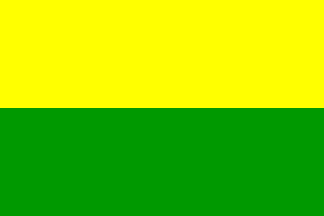 image by Ivan Sache, 22 June 2017
image by Ivan Sache, 22 June 2017
The I.E. (Institución Educativa) de Baranoa "Julio Pantoja Maldonado"
(English: Educational Institution of Baranoa) "Julio Pantoja
Maldonado") is a high school located in Atlántico.
Its flag is seen here:
http://4.bp.blogspot.com/_CSAGzC3-UOU/ShBD69f-gMI/AAAAAAAAAJU/ENcC4XgDnxE/s1600-h/BANDERA.jpg
(source: http://julio-pantoja.blogspot.com.co/2009/05/simbolos.html). It is
a horizontal flag with two equally divided stripes, yellow on top and green
on the bottom. It represents hope (green) and the road to enlightenment
(yellow).
Esteban Rivera, 21 June 2017
The school originates in the establishment in 1945 of a branch of the
Industrial School Pedro A. Oñoro dedicated to craft industry. This was
transformed in 1957 into the Colegio Bachillerato. Colegio Bachillerato Mixto de
Baranoa (COMIXBA) was established on 11 December 1958 by Departmental Order No.
67.
The school's namesake is the teacher Julio Pantoja Maldonado
(1898-1975). On 28 November 1918, bells were ring and bonfires were shot in
Baranoa to celebrate the graduation of the first local teachers; Pantoja was
among them. In 1919, he was appointed Director of the Annex Boy's Normal School,
where he taught Pedagogy and Spanish. Awarded in 1933, the title of Expert in
Education, he studied at the Bogotá Superior Normal School, under the guidance
of the French americanist Paul Rivet (1876-1956; founder of the Musée de l'Homme
in Paris in 1937 and head of the anti-German resistance group set up in the
museum). Pantoja subsequently served as Inspector of Education for the Tolima
Department (1934-1935), Director of Education for the Department of Atlántico
(1935-1939), Rector of Colegio Barranquilla (1940), and rector of the school
that would be named after him (1959-196/).
http://loademibaranoa.260mb.com/contexto_institucional.html?i=1
Ivan Sache, 22 June 2017
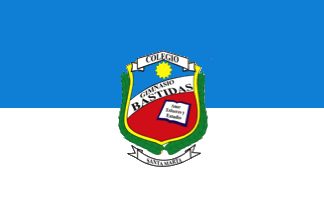 image by Ivan Sache, 13 May 2021
image by Ivan Sache, 13 May 2021
Colegio Gimnasio Bastidas is located in Santa Marta (Magdalena).
The flag of Colegio Gimnasio Bastidas is horizontally divided king
blue-white with the school's coat of arms in the center.
King blue symbolizes wisdom and the force that pushes great ideals.
White is a symbol of peace, harmony and purity of the pupils.
On the coat of arms, the sun on the blue field represents light that
guides on the way of knowledge. The open book on the red field is
inscribed with the school's motto, "Amor Esfuerzo y Estudio" (Love Force
and Study).
Source: school blog
Ivan Sache, 13 May 2021
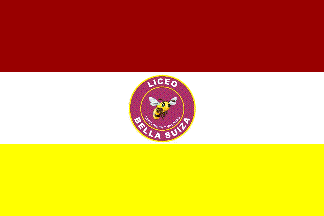 image by Ivan Sache, 28 July 2014
image by Ivan Sache, 28 July 2014
Liceo Bella Suiza is located in the Bella Suiza housing estate, part of the
municipality of Cali (Valle del Cauca Department).
The flag of the institute is horizontally divided wine red-white-golden yellow
with the institute's emblem in the middle of the white stripe. Wine red is a
symbol of leadership, love, and passion. White is a symbol of honesty,
transparency, sincerity, and peace. Golden yellow is a symbol of spiritual
resources, joy, strength, and organization of the youth.
The emblem of the institute has the same colours as the flag. The two
concentric, red wine disks and the border symbolize knowledge, the institutional
values, and harmony. The inner disk is charged with the institute's mascot - a
bee- and the white writing "EXCELENCIA - VALORES" (Excellence - Values). The
outer disk is inscribed with the institute's name written in white letters.
The mascot of the institute is a bee, a symbol of perseverance and commitment to
work, required for continuous improvement and the achievement of our goals.
Source:
http://unogroupusa.com/liceobellasuiza/index.php?option=com_content&view=article&id=50&Itemid=67
- Institute's website
Photos (Gallery
"Izada de Bandera 30 / Septiembre de 2013)
[On the flag in actual use, the emblem does not overlap the coloured stripe as
shown on the drawing of the flag on the institute's website.]
Ivan Sache, 28 July 2014
 image by Zoltan Horvath, 25 November 2014
image by Zoltan Horvath, 25 November 2014
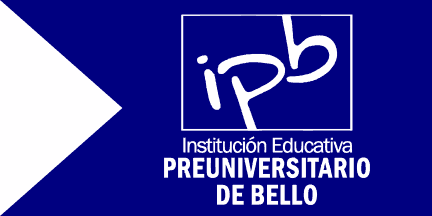 image by Zoltan Horvath, 25 November 2014
image by Zoltan Horvath, 25 November 2014
On October 22 I passed by the offices of the IPB (Instituto Preuniversitario
de Bello) (Pre University Institution of Bello), located in
Bello.
It was established in 1988.
Source:
http://4.bp.blogspot.com....jpg
Its flag is located
here.
However, the flag I saw seems to be the
flag
with the
logo
in the middle.
Image of flag.
I think (since I saw the flag folded, I didn't have a chance to see it all) it
is this version, since there are no colors faded in the picture, nor I recall
having seen like that, so it's just plain colors with the logo and the name of
the institution below, as drawn.
For additional information go to:
IPB (Instituto Preuniversitario de Bello)
Esteban Rivera, 25 November 2014
Well, the photograph shows the hoist in part to be blue, so to begin with
it's not derived from the flag with the white hoist triangle. Assuming the
charge is in the centre, to have it hang in front of the bottom hoist corner,
the flag would have to be circa. 3:5. So, if only the blue part of the flagstaff
were the hoist, it hanging so much lower would suggest a much longer flag. It
would seem more likely that the white part is not the staff, but is part of the
hoist as well: A shorter, e.g. 2:3 flag with the hoist blue over white. A likely
candidate would be two stripes blue over white.
The charge does seem to have the i and the tip of the p, from the logo. They
seem to be within a rectangle of sorts, with one corner very close to the
dividing line of blue and white. That rectangle then appears to be on a disk a
bit smaller then the charge of the national flag next to it. (For what would be
the bottom of the disk it seems to merge with the white.) That whole construct
doesn't seem to make sense, except if, like the national flag, the flag is
rotated. In that case the vertical edge of the logo box are actually aligned
with the diagonal of the flag, to make it come out upright with the flag furled
as it is here. Imagining a full circle and considering the p in the logo extends
lower than the i, I'd say there's not going to be much room for other lettering
than the ipb in the logo box.
Peter Hans van den Muijzenberg, 08 April 2015
 image by Ivan Sache, 5 July 2014
image by Ivan Sache, 5 July 2014
Colegio Benedictino de Santa María was established on 17 February 1958 in
Envigado (Antioquia Department).
The flag of
the institute is horizontally divided blue-white-yellow, merging the Marian and
Papal banners. The flag to be used during special events is charged with the
institute's emblem in the middle of the white stripe.
Blue is the colour
of the Blessed Virgin, as a source of life and a symbol of water, and of
infinite space and unstained heavens. White is the fusion of all colours,
therefore a symbol of unity, family, and peace. Yellow is a symbol of light,
energy, spirit, joy, strong-mindedness; it is the colour of God and of the sun.
http://www.colegiobenedictino.edu.co/index.php/bandera
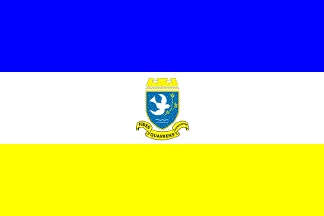 image by Ivan Sache,
5 July 2014
image by Ivan Sache,
5 July 2014
The emblem of the institute is made of three parts. The yellow crown outlined
in black recalls the Virgin of Montserrat, the patron saint of Catalonia and of
the Montserrat monastery, founder of the Santa María de la Asunción monastery in
Envigado. The blue shield is charged with a white flying dove holding in the
beak a branch of olive, a symbol of peace. The dove recalls Christopher
Columbus, Colombia's namesake; "columba" means "a dove" in Latin. The two waves
in the base of the shield represent the two most important rivers in Colombia,
Magdalena and Cauca, which were the very first means of transportation and
spread of culture. The yellow scroll placed beneath the shield is inscribed with
the Latin motto of the institute, "FIDES QUARENS INTELLECTUM", "Faith in Search
of Understanding", a motto coined by St. Anselm of Canterbury (1033-1109).
http://www.colegiobenedictino.edu.co/index.php/escudo - Institute's website
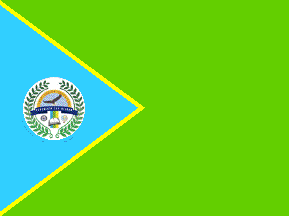 image by Ivan Sache, 8
March 2017
image by Ivan Sache, 8
March 2017
Institución Educativa Benedikta Zur Nieden is established in Itagüí,
Antioquia Department.
Benedikta Zur Nieden (1910-1998) studied arts in
Berlin, where she met her husband, Diego Echavarría Misas. The couple moved in
1934 to Medellín, where they were involved in several philanthropic activities,
being locally known as "Don Diego and Doña Dita". In 1969, Benedikta Zur Nieden
established the Colegio Alemán in Itagí. After the abduction and assassination
of her husband in 1971, she retired in El Castillo estate, today a museum. She
reorganized the Antioquia Symphonic Orchestra and founded a music academy for
the youth. Benedikta Zur Nieden introduced in Colombia the Waldorf method, in
which arts play a key role in education; she founded in 1985 Colegio Isolda
Echavarría, named for her late daughter, and Centro Humanistico Micael.
Complete biography, Colegio Alemán website
The flag of the institute is green with a blue triangle
placed along the hoist, fimbriated yellow and charged
with the institute's emblem.
Blue represents the professionalism, capacities, skills , knowledge, wisdom, and confidence of every member of the
educational community, required to reach educational quality and excellence.
Green represents knowledge brought by the institute to the students. Green is a
symbol of growth, serenity, ethics, and compromise with the natural environment.
Yellow represents dynamism, warmth, joy, and the light that guides the decision
taken in favour of the educational community.
institute website
The emblem of the institute symbolizes it as a
rising sun and harmonious relations, allowing the students to shine through
culture, science, wisdom, research, technology, and knowledge required to access
the world. The emblem represents the force, passion, and valiance of the
educational community, required to project itself in the social context.
The eagle is a symbol of the student's perseverance and vision required to achieve
their dreams and a big life's project. Its flight represents the student's swift
thinking, cleverness, mental plasticity, and nobleness, requited to live in a
competing world, and initiative to achieve high goals with transcendental
decisions. It represents the professionalism, capacities, skills, knowledge,
wisdom, and confidence of every member of the educational community, required to
reach educational quality and excellence. It also represents the commitment of
the teachers to always fly high, to look at issues from an elevated angle, and
to search for the relevant answers.
The sun represents the institution and
teacher's force and responsibility, when developing minds, acquiring knowledge
and articulate all the elements to provide an excellent education.
The spikes represent union and team work, and the need to build a peaceful and sustainable
society. They also represents the student's moral and spiritual values.
The open book placed over the the colours of the institute's flag represents
knowledge and wisdom, the commitment of the institution to a quality education
that will teach competent and competitive students and develop as far as
possible their potential and communication, research, environmental, cultural
and social skills.
The compass represents the horizon proposed by the
institute to the students for the construction of their life's project.
The globe expresses harmony, respect and compromise with the planet and the natural
environment. It represents innovation, science and technology, knowledge and
universal culture.
Source: institute website
Ivan Sache, 8 March 2017
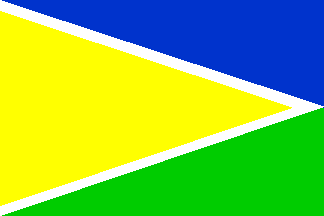 image by Ivan Sache, 5 March 2017
image by Ivan Sache, 5 March 2017
Institución Educativa Benedikta Zur Nieden, formerly known as Colegio San
Juan Eudes, originates in Escuela Urbana de Niñas San Juan Eudes, established on
28 November 1959 by Resolution No. 21 in the Campo Alegre borough, Medellín,
Antioquia Department. Colegio San Juan Eudes was established on 24 September
1999 by Resolution No. 8,558.
The name of the institute was changed in 2001
for the sake of differentiation from another Colegio San Juan Eudes; Agreement
No. 2, issued on 30 April 2001, confirmed the proposal made on 18 April 2001 by
a three-member jury. The selected name is a tribute to Benedikta Zur Nieden, a
German lady awarded in 1988 the title of "Woman of Antioquia" for her
contribution to the cultural land educational development of Antioquia,. Colegio
Benedikta Zur Nieden was established on 22 May 2001 by Resolution No. 4,107.
Institución Educativa Benedikta Zur Nieden was formed on 8 May 2003 by
Resolution No. 038bis, as the merger of Escuela Especial Municipal San Javier,
Escuela Carlos Vieco Ortiz, Escuela Juan de Dios Aránzazu, and Colegio Benedikta
Zur Nieden. The three Escuelas were subsequently transferred to
Institución Educativa Carlos Vieco Ortiz,
established on 20 December 2010 by Resolution No. 16,732.
institute constitution
Benedikta Zur Nieden (1910-1998) studied arts in
Berlin, where she met her husband, Diego Echavarría Misas. The couple moved in
1934 to Medellín, where they were involved in several philanthropic activities,
being locally known as "Don Diego and Doña Dita". In 1969, Benedikta Zur Nieden
established the Colegio Alemán in Itagüí. After the abduction and assassination
of her husband in 1971, she retired in El Castillo estate, today a museum. She
reorganized the Antioquia Symphonic Orchestra and founded a music academy for
the youth. Benedikta Zur Nieden introduced in Colombia the Waldorf method, in
which arts play a key role in education; she founded in 1985 Colegio Isolda
Echavarría, named for her late daughter, and Centro Humanistico Micael.
Complete biography, Colegio Alemán website
The symbols of the institute are prescribed in Chapter 3 of the institute's Constitution.
The flag is described in Article 11, as follows:
Structure. Rectangular, divided by
oblique lines forming three triangles that unite to form a pyramid, the upper
triangle blue, the lower, yellow, and the central green. The colours are the
same as on the coat of arms.
Meaning
Blue (2945 cv) is a symbol of
tranquility and balance of an integral and dynamic education.
Green (316 cv)
is a symbol of the aspiration of education to alleviate the life's concern and
find proper solutions to issues.
Green is also a symbol of the natural
environment and ecology.
Yellow is a symbol of life and joy, which is the
main pillar of education, and therefore, "supporting" the two other colours on
the flag.
manual de convivencia
Ivan Sache, 5 March 2017
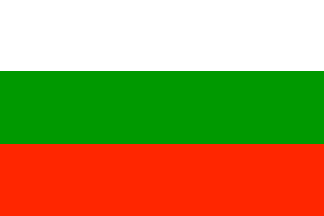 3:5 image by Ivan Sache, 11 September 2022
3:5 image by Ivan Sache, 11 September 2022
image at: inssebehe.edu.co (archived)
I.E. Benjamín Herrera (INSEBEHE) is located in borough San José de Turbaquito,
municipality of Arjona (department of Bolívar). The school was established by
Decree No. 734 issued on 13 September 1961.
The school's namesake is General
Benjamín Herrera (1850-1924), co-founder of Universidad Libre.
The flag
of INSEBEHE is horizontally divided white-green-red.
White represents purity
and honesty.
Green represents hope.
Red represents strength, perseverance
and love.
http://insebehe.edu.co/simbolos.html - School website
Ivan Sache, 11 September 2022
See also, by the way, how this flag itself and its underlying pattern
are used on murals and other wall decoration in the school facilities:
[1],
[2].
I presume this is something not unique to this particular school, and
that most of these so many Colombian school flags are used in a similar
manner.
António Martins-Tuválkin, 3 June 2025